Rebecca Roberts introduces Gold of The Great Steppe, the first UK exhibition of recently excavated 2,700 year-old gold artefacts unearthed in remote burial mounds of East Kazakhstan. The Saka culture of Central Asia, flourishing from the 8th-3rd centuries BCE, was part of the Scythian world that dominated the Eurasian steppe zone from the Black Sea to Siberia. Located in the Altai mountain system, the Saka of East Kazakhstan were a vibrant society that occupied a landscape of open skies, rolling plains, winding rivers, creeping marshes, and soaring mountains. Based on discoveries made during an ongoing programme of excavation by archaeologists in the East Kazakhstan region, many of the artefacts were unearthed during the pandemic. They represent the resilience and determination of Kazakhstani archaeologists to protect and document their heritage, which is under threat from looting and degradation due to climate change. This exhibition is a partnership between the East Kazakhstan Regional Museum of Local History and the University of Cambridge. It will bring to the UK and display Kazakhstani archaeological finds and research from three different burial complexes in East Kazakhstan: Berel, Shilikti and Eleke Sazy. The show places archaeological finds discovered in the last three years by Kazakh archaeologists on a western global stage for the first time, amplifying voices that often go unheard in UK museums.
MONGOLS CHINA AND THE SILK ROAD
Archaeology and History of the Silk Road
Sunday 31 October 2021
Friday 11 September 2020
Rebuilding Anatolia after the Mongol Conquest
Rebuilding Anatolia after the Mongol Conquest: Islamic Architecture in the Lands of Rum, 1240–1330
(Birmingham Byzantine and Ottoman Studies) Hardcover / Paperback/ Kindle
- Hardcover : 272 pages
- ISBN-10 : 1472424069
- ISBN-13 : 978-1472424068
- Product Dimensions : 18.42 x 2.54 x 26.04 cm
- Publisher : Routledge
Wednesday 9 September 2020
Islam, Literature and Society in Mongol Anatolia
Islam, Literature and Society in Mongol Anatolia
- ISBN-10 : 1108713483
- Paperback : 323 pages
- ISBN-13 : 978-1108713481
- Publisher : Cambridge University Press (12 Nov. 2020)
- Language: : English
The Great Mongol Shahnameh
- Hardcover : 544 pages
- ISBN-10 : 1898113831
- ISBN-13 : 978-1898113836
- Product Dimensions : 30 x 15 x 32.7 cm
- Publisher : Yale University Press (23 Feb. 2021)
- Language: : English
Tuesday 8 September 2020
1700 year old face behind stunning mask from Eastern Siberia region ( north of Mongolia)
Lifelike face of a tattooed Tashtyk man seen for first time behind a stunning gypsum death mask
Aged 25 to 30 when he died 1,700 years ago, he is from the mountainous region of modern-day Khakassia.
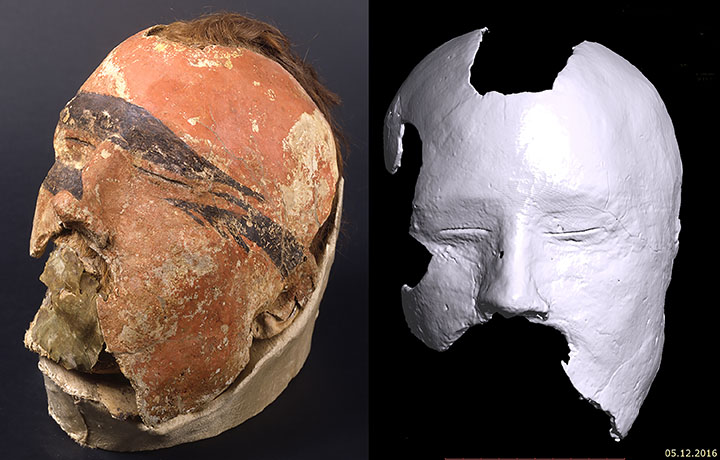
Male Tashtyk mask is kept in the State Hermatage Museum. CT of the mask layer. Pictures: © The State Hermitage Museum. Photo by Vladimir Terebenin, Pavel Demidov, Darya Bobrova
A new CT scan has revealed the face behind his painted gypsum death mask that were all the rage with the ancient Tashtyk people, who were settled cattle-breeders and farmers known for their idiosyncratic burial rituals.
He had brown hair, although the scan gives him a red punk look, and it is believed the pigtail he would have worn had been cut off before his burial.
He is also the only Tashtyk mummy so far found with tattoos.
But the most striking and unexpected aspect is a long suture on the side of his face: from the left eye to the ear.
A scar that had been sewn up.
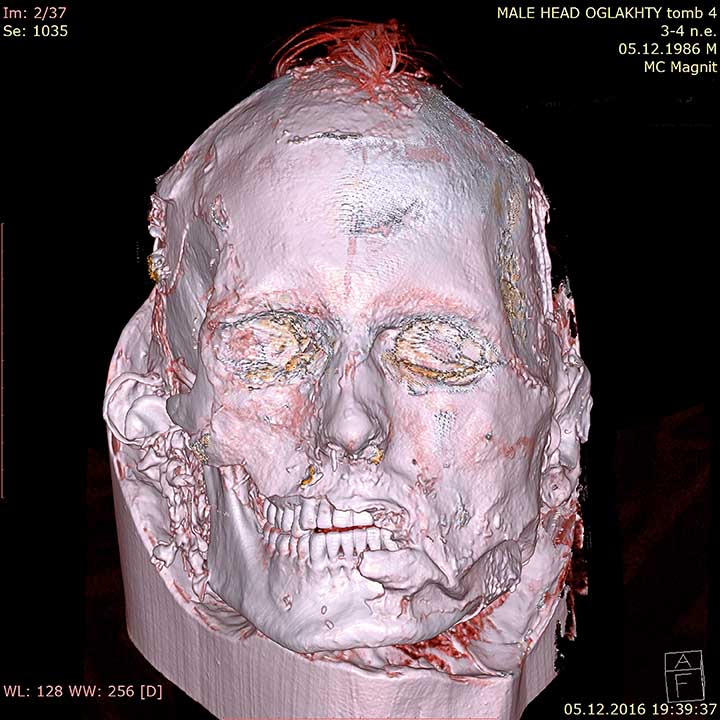
The most striking and unexpected aspect is a long scar on the side of his face: from the left eye to the ear. Picture: The State Hermitage Museum
Archaeologists want more research on this but the current best guess is that this suture was stitched after his death - perhaps to mend his disfigured face after a wound, possibly a fatal blow.
In other words, to improve his looks before his journey to the afterlife.
Final confirmation is still needed that this facial embroidery was postmortem, however.
For now it is not ruled out that this repair job was done at the end of his life.
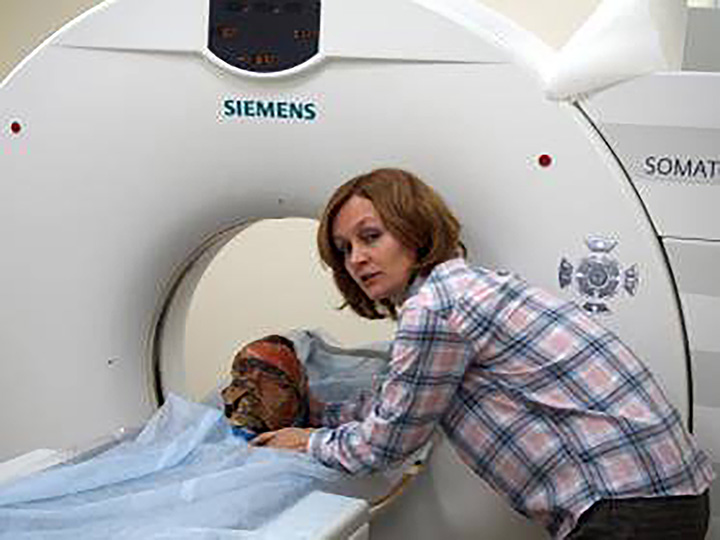
Dr Svetlana Pankova put the male head into the CT scan. Picture: The State Hermitage Museum
Nor was this the only evidence of intervention by ancient surgeons on this Tashtyk man found at the Oglakhty burial ground, and laid to rest in a burial log house.
‘His skull was trepanned in the temporal area on the left side,’ explained Dr Svetlana Pankova, curator at the State Hermitage Museum, St Petersburg, and keeper of the Siberian collection of the Department of Archeology.
‘The hole is rather big - 6 by 7 centimetres. It was made postmortem.
‘Expert analysis shows the hole was made by the series of blows with a chisel type or hammer type tool.’
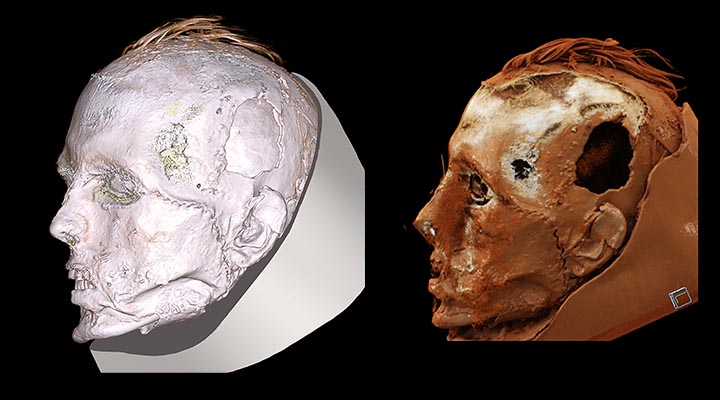
‘His skull was trepanned in the temporal area on the left side.' Pictures: Paul Goodhead, The State Hermitage Museum
Dr Pankova said: ‘We think that it was made to remove the brain during an elaborate burial rite.’
Likewise she thinks the facial scar can be explained in similar fashion.
‘They took all these postmortem rites very seriously, and did not save on this,’ she said.
‘They could not just put a mask on the disfigured face.
‘It would be great to attract an experienced surgeon to research this suture, to get full clarity. Was it postmortem or might it have been been made in his lifetime?
‘Our research is complicated by the fact that we cannot take the mask away from the face (it would cause too much damage) so we must research this stitching using other methods.’
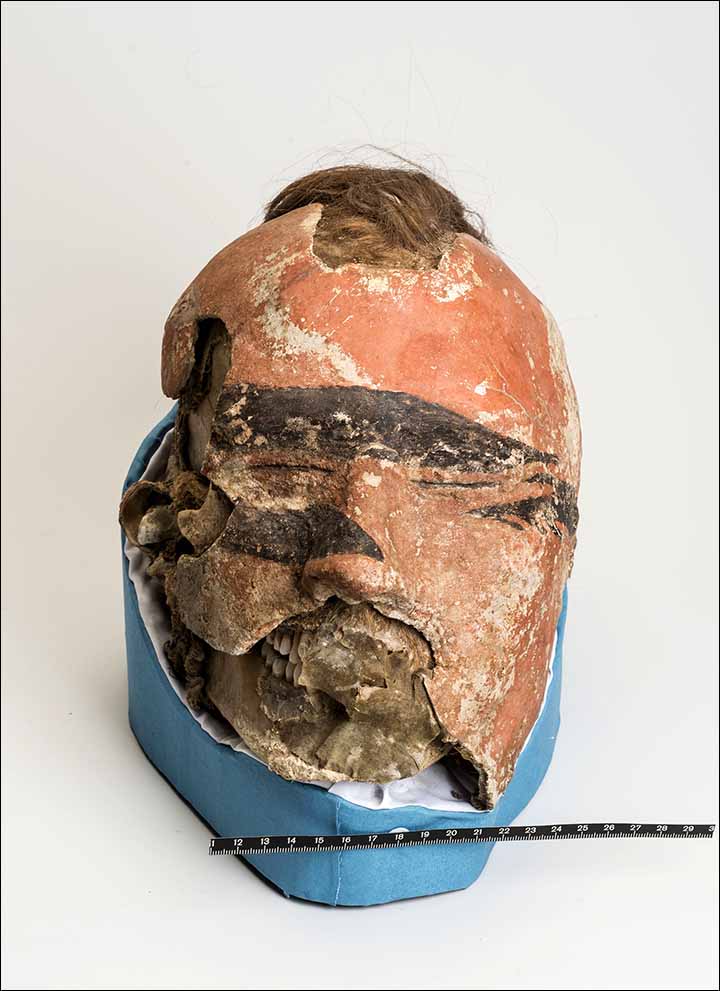
Male mask has black stripes on a red background, plus the lower part of the mask was destroyed and man's teeth can be seen. © The State Hermitage Museum. Photo by Vladimir Terebenin, Pavel Demidov, Darya Bobrova.
The archadologists were intrigued to finally see the face under the death mask, the painting of which ‘adds some unnecessary emotional impressions’
Dr Pankova said the mask 'has black stripes on a red background, plus the lower part of the mask was somewhat destroyed and man's teeth can be seen.
‘So all together it creates such an aggressive look.’
Yet under the mask ‘there was nothing aggressive in this face.
‘It was the face of a calmly sleeping person.
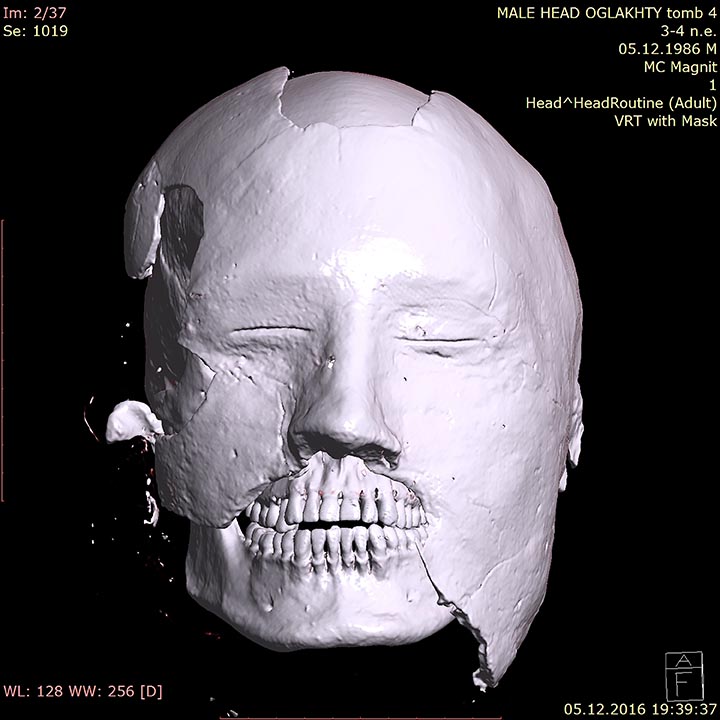
‘It was the face of calmly sleeping person.' Picture: The State Hermitage Museum
‘The mask was very close in appearance to the real face.
‘For the first time we see the real face of a young man of this time…
‘The computer scan allowed us to see, so to say, three layers - the layer of the mask, the layer of the face without the mask and layer of the skull.’
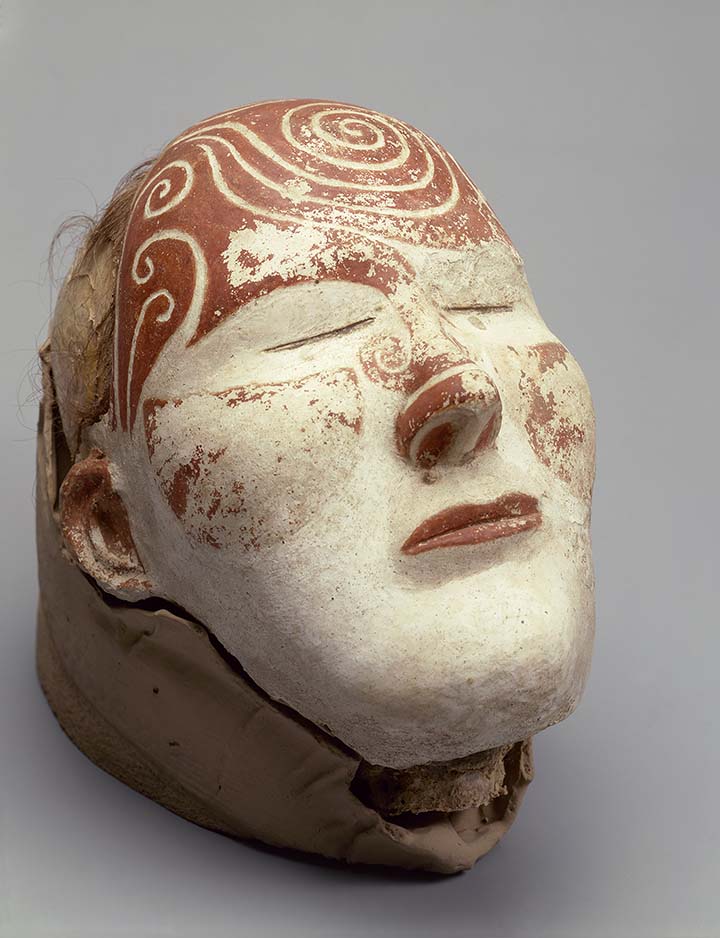
Svetlana Pankova: ‘I would really like to make CT scan of female mummified head.' © The State Hermitage Museum. Photo by Vladimir Terebenin, Pavel Demidov.
The face of the woman lying in the same burial chamber - also buried in a fur coat - has not been revealed with a CT scan.
Or anyway not yet.
‘I would really like to make CT scan of female mummified head,’ she said.
‘I am planning to find a clinic which can do this research and decipher it for us.’
For now we do not know who the woman was and how she and the man were related.
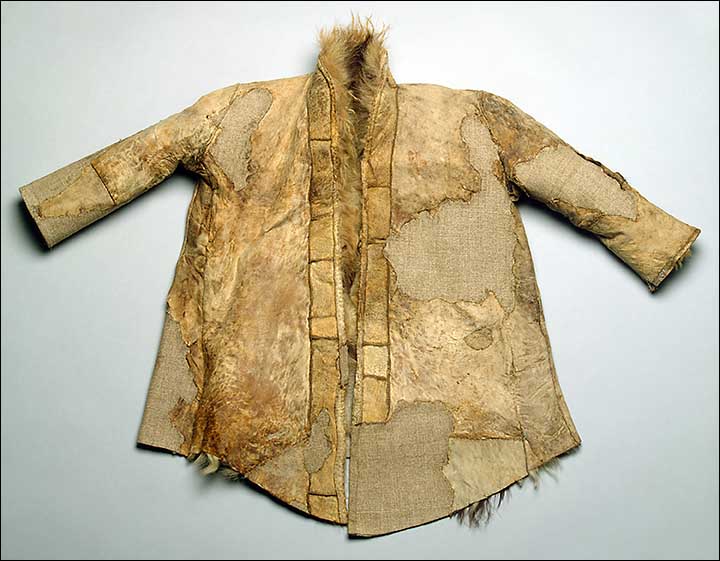
Children's fur coat was also found in the grave. © The State Hermitage Museum. Photo by Vladimir Terebenin, Pavel Demidov.
A child’s skeleton was also found in the same grave.
So, too, were two burial ‘dummies’ - an extraordinary phenomenon akin to stuffed dolls or mannequins.
These may be explained by the merging of two cultures or traditions: one that buried their dead, the other that cremated.
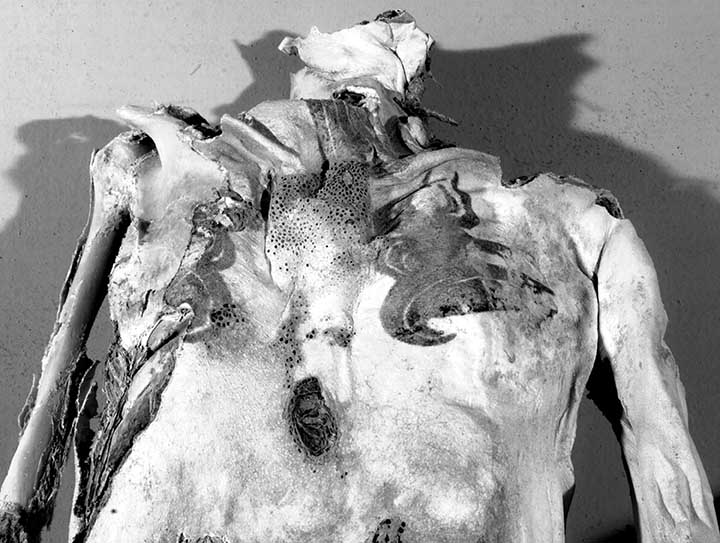
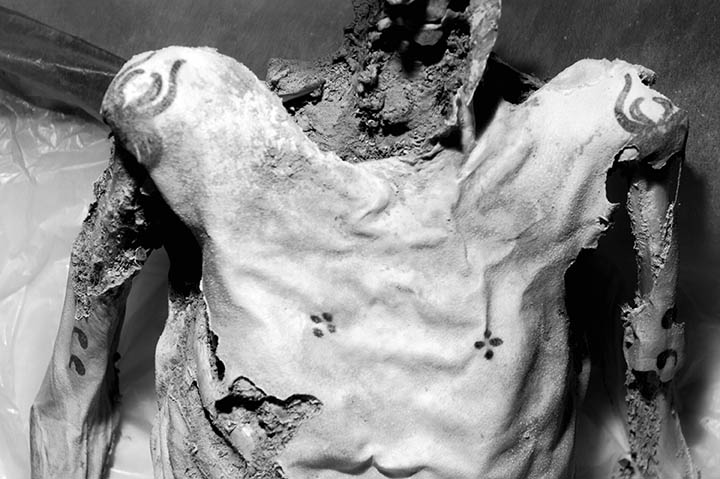
He is also the only Tashtyk mummy so far found with tattoos. Infrared photography. Pictures: The State Hermitage Museum
The dummies appear to represent the remains of those who were cremated.
Yet there is also evidence that men were more usually cremated while women and children were buried.
‘The dummies in full height, kind of mannequins, were made of leather, filled with tightly twisted grass,’ said Dr Pankova.
‘In the chest area there were leather pouches with charred bones remaining from cremations.’
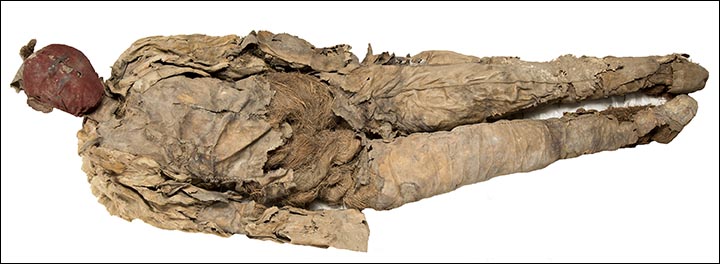
‘The dummies in full height, kind of mannequins, were made of leather, filled with tightly twisted grass.’ © The State Hermitage Museum. Photo by Vladimir Terebenin, Pavel Demidov
She told The Siberian Times: ‘The mummies, male and female, were dressed in fur coats, and they had masks on their faces.
‘The head of one of the dummies did not preserve.
‘Sadly, probably rodents sneaked in and spoiled it.
‘The second dummy has the face, covered with bright red woollen fabric, with eyes and a nose. On the head was a piece of Chinese silk.’
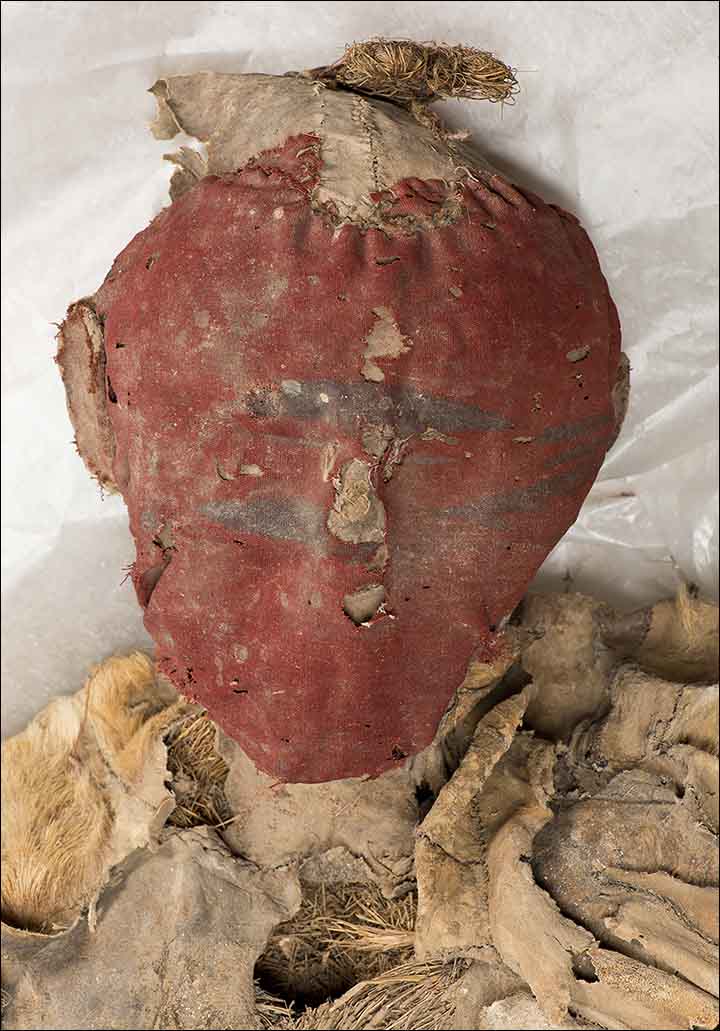
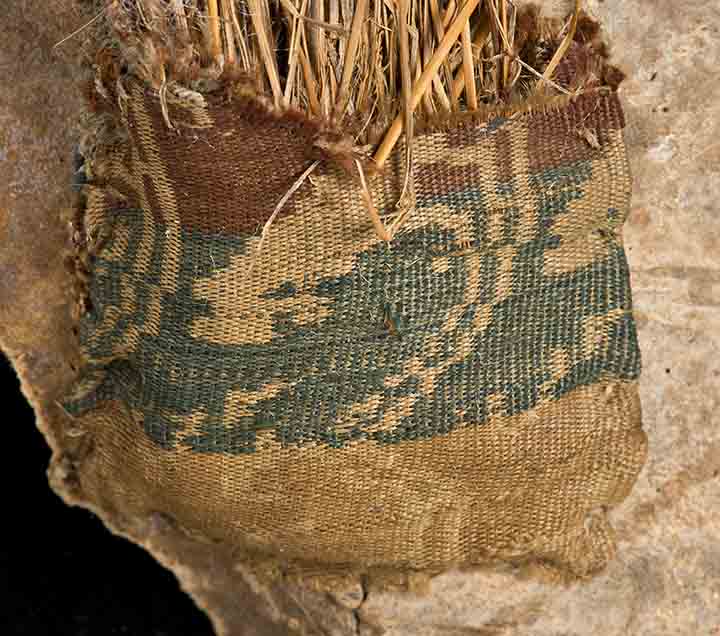
‘The second dummy has the face, covered with bright red woollen fabric, with eyes and a nose. On the head was a piece of Chinese silk.’ © The State Hermitage Museum. Photo by Vladimir Terebenin, Pavel Demidov.
The Tashtyk culture existed between the first and seventh centuries AD in the area of so-called Minusinsk Basin of the Yenisei valley.
They were settled cattle breeders and farmers.
In 1969 Professor Leonid Kyzlasov excavated the Oglakhty burial ground and found this masked man in tomb number four.
‘We made the radiocarbon dating using larch of the log house indicating the third to fourth centuries AD.'
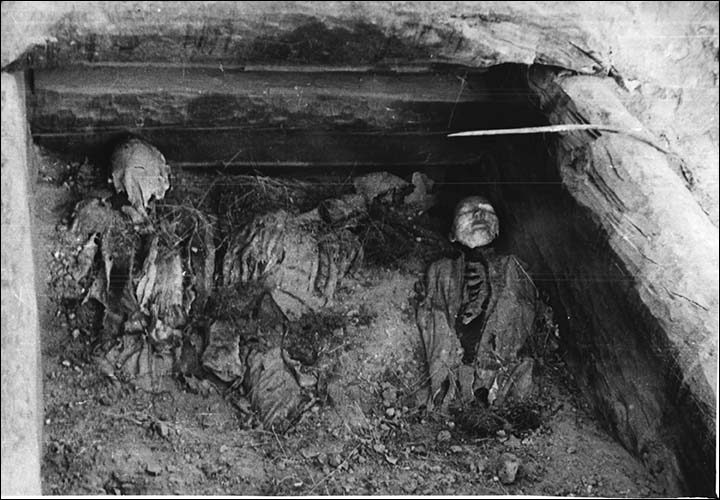
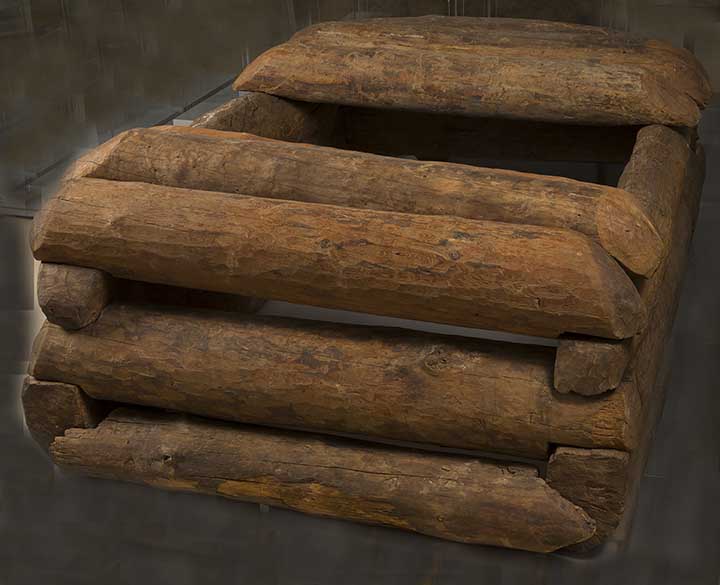
In 1969 Professor Leonid Kyzlasov excavated the Oglakhty burial ground and found this masked man in tomb number four. Pictures: Leonid Kyzlasov, The State Hermitage Museum/ Vladimir Terebenin
The Oglakhty necropolis was originally found in 1902 by a shepherd, who fell into one of the graves, saw the people in a wooden chamber with whitish masks on their faces, got scared, and fled.
His mother-in-law was more fearless, sneaking in and looting some items.
Local official and researcher Alexander Adrianov heard about this and started excavations in 1903, unearthing three graves.
Monday 15 June 2020
The Cultures of Ancient Xinjiang
The Cultures of Ancient Xinjiang, Western China: Crossroads of the Silk Roads
- Paperback: 218 pages
- Publisher: Archaeopress (19 Dec. 2019)
- Language: English
- ISBN-10: 178969406X
Wednesday 6 May 2020
The Wonders of Creation and the Singularities of Painting
A Study of the Ilkhanid London Qazvini (Edinburgh Studies in Islamic Art)
by Stefano Carboni- Paperback: 456 pages
- Publisher: Edinburgh University Press (11 Feb. 2020)
- Language: English
- ISBN-10: 1474461395
Al-Qazwini's Wonders of Creation is one of a handful of extant illustrated codices produced under the Mongols of Persia. Al-Qazwini collected, edited and assembled a large body of literary works into a single text that reflects the cultural world of a medieval Arab encyclopaedist. In this lavishly illustrated volume, Stefan Carboni analyses the manuscript's miniatures, discusses the 368 paintings that illustrate the codex, and includes a partial critical translation of the related Arabic text. The codex contains a copy of a cosmographical text written in Arabic in Baghdad towards the end of the 13th century. The cosmography represents a physical description of the world arranged from the outer spheres of the universe, where the throne of God, the Angels and the Planets are located, down to Earth where the Peoples living in the Islands of the Oceans, the Mineral, the Vegetal and the Animal Kingdoms are described throughout the text. About the series: Edinburgh Studies in Islamic Art offers readers easy access to the most up-to-date research across the whole range of Islamic art, representing various parts of the Islamic world, media and approaches. Books in the series are beautifully illustrated academic monographs of intellectual distinction that mark a significant advance in the field.
Tuesday 5 May 2020
Uzbekistan: The Road to Samarkand
- by Yaffa Assouline (Author), Laziz Hamani (Photographer)
- Hardcover: 336 pages
- Publisher: Assouline Publishing (February 26, 2020)
- Language: English
- ISBN-10: 1614288917
At the heart of Central Asia lies a land where colossal mountains and sweeping valleys sleep under a blanket of lush greenery. Crowned with golden palaces and wondrous monuments, the architectural landscape of the region is so rich with detail, the structures have been said to mirror the heavens themselves. One of the few destinations on Earth where imagination aligns with reality, Uzbekistan flourishes with unparalleled scenery and unforgotten traditions. The towns and cities are like ‘open museums’, each edifice offering a unique and intricate aesthetic, each a testament to diverse cultural influences and diverse periods of history. Nature and architecture have a unique relationship, seemingly inspired by each other, as if they were trying to to outdo each other with their beauty. Discover the beautiful colors, textures and flavors of this incredible culture and journey through the cities of the Silk Road and the lands of Alexander The Great with stunning original photography by Laziz Hamani.

Visualizing Dunhuang
- Paperback: 400 pages
- Publisher: Princeton University Press (17 Nov. 2020)
- Language: English
- ISBN-10: 0691208166
A beautifully illustrated study of the caves at Dunhuang, exploring how this important Buddhist site has been visualized from its creation to today.
Situated at the crossroads of the northern and southern routes of the ancient silk routes in western China, Dunhuang is one of the richest Buddhist sites in the world, with more than 500 richly decorated cave temples constructed between the fourth and fourteenth centuries. The sculptures, murals, portable paintings, and manuscripts found in the Mogao and Yulin Caves at Dunhuang represent every aspect of Buddhism. From its earliest construction to the present, this location has been visualized by many individuals, from the architects, builders, and artists who built the caves to twentieth-century explorers, photographers, and conservators, as well as contemporary artists.
Visualizing Dunhuang: Seeing, Studying, and Conserving the Caves examines how the Lo Archive, a vast collection of photographs taken in the 1940s of the Mogao and Yulin Caves, inspires a broad range of scholarship. Lavishly illustrated with selected Lo Archive and modern photographs, the essays address three main areas
-Dunhuang as historical record, as site, and as art and art history.
Leading experts across three continents examine a wealth of topics, including expeditionary photography and cave architecture, to demonstrate the intellectual richness of Dunhuang. Diverse as they are in their subjects and methodologies, the essays represent only a fraction of what can be researched about Dunhuang. The high concentration of caves at Mogao and Yulin and their exceptional contents chronicle centuries of artistic styles, shifts in Buddhist doctrine, and patterns of political and private patronage-providing an endless source of material for future work.
Contributors include Neville Agnew, Dora Ching, Jun Hu, Annette Juliano, Richard Kent, Wei-Cheng Lin, Cary Liu, Maria Menshikova, Jerome Silbergeld, Roderick Whitfield, and Zhao Shengliang.
Published in association with the Tang Center for East Asian Art, Princeton University
Saturday 2 May 2020
Mystery of unique 2,100-year-old human clay head
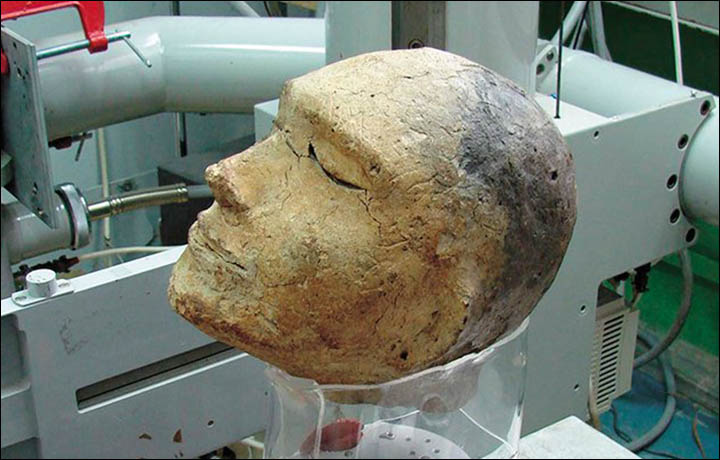
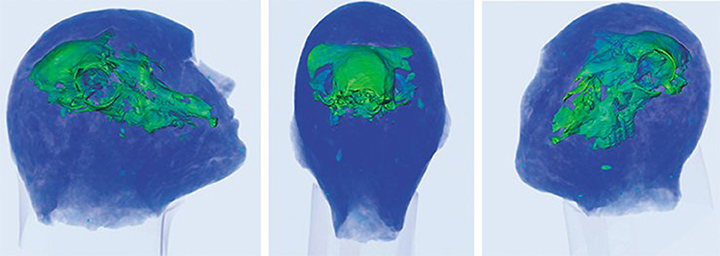
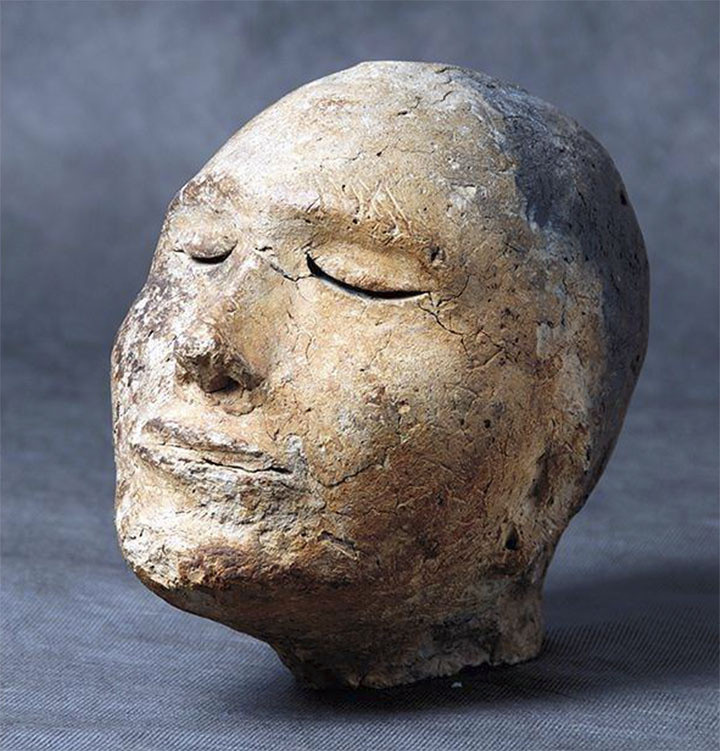
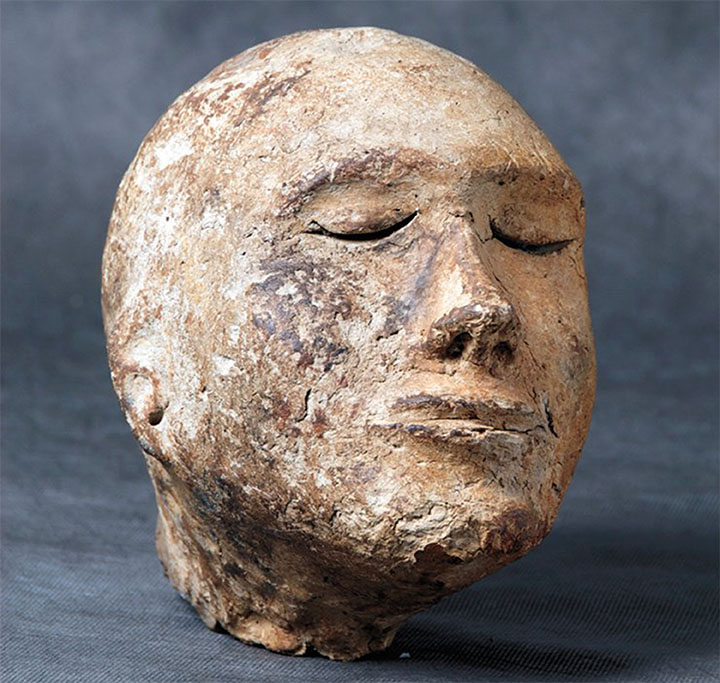
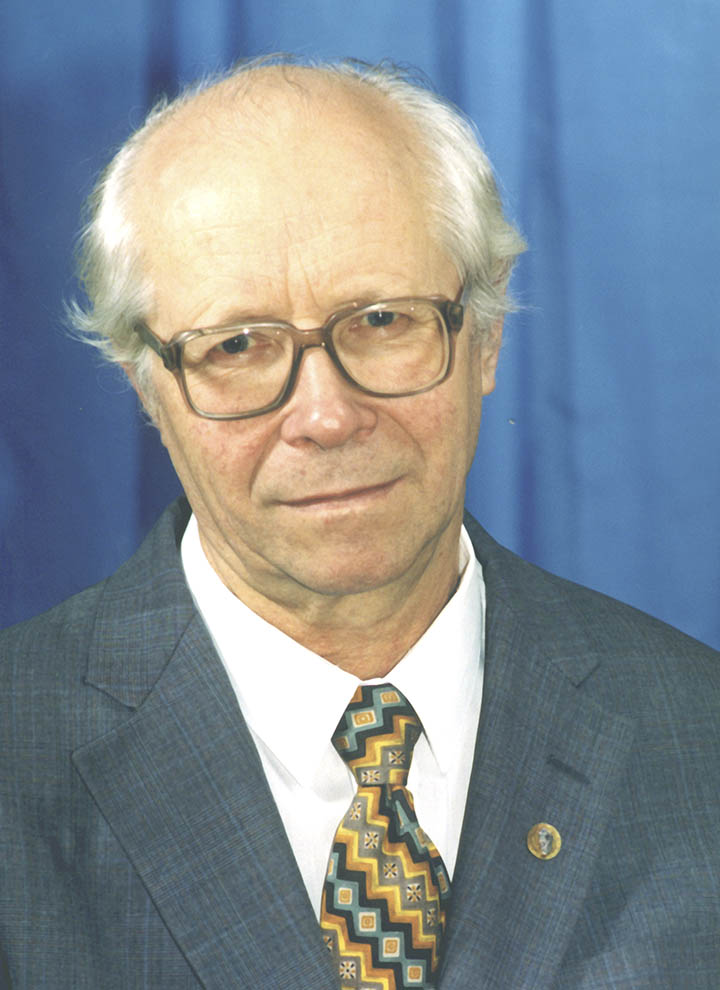
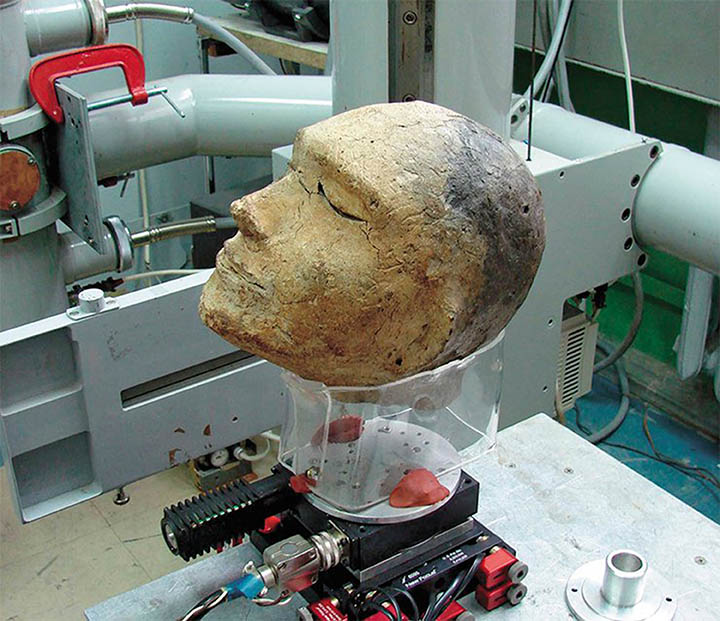
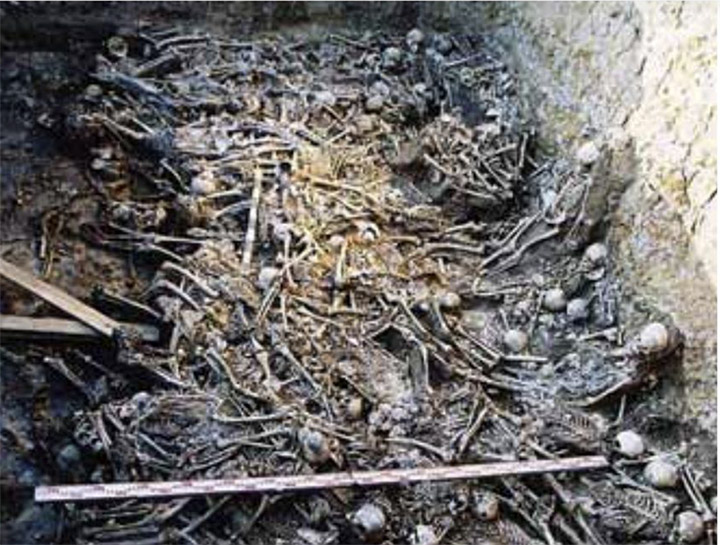
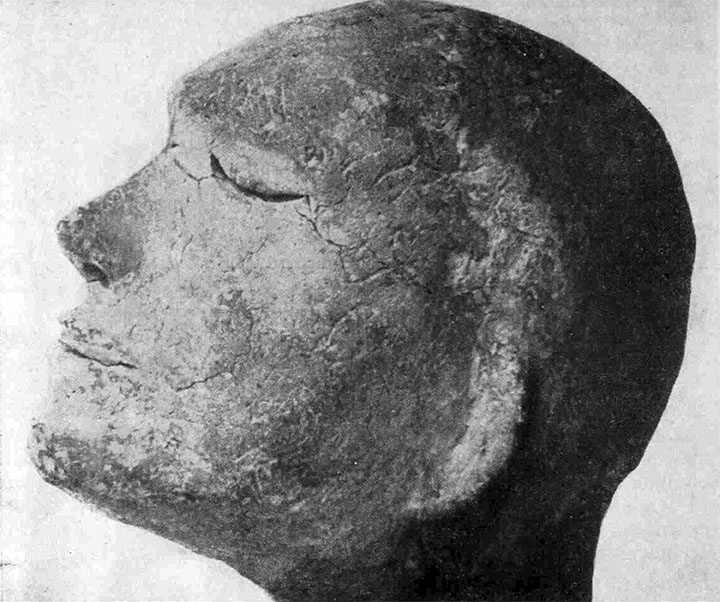
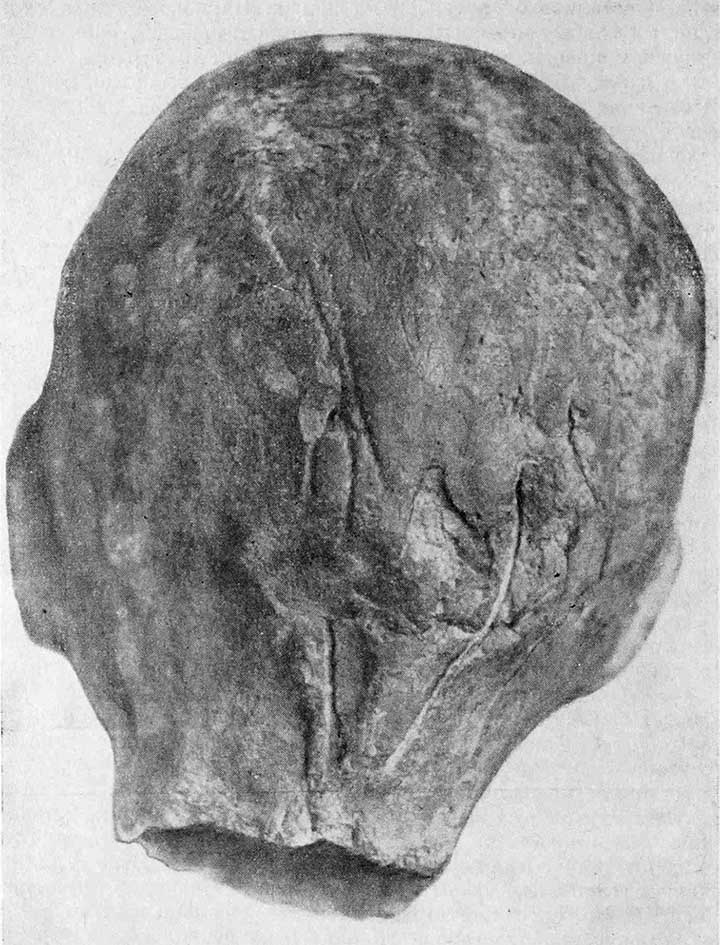
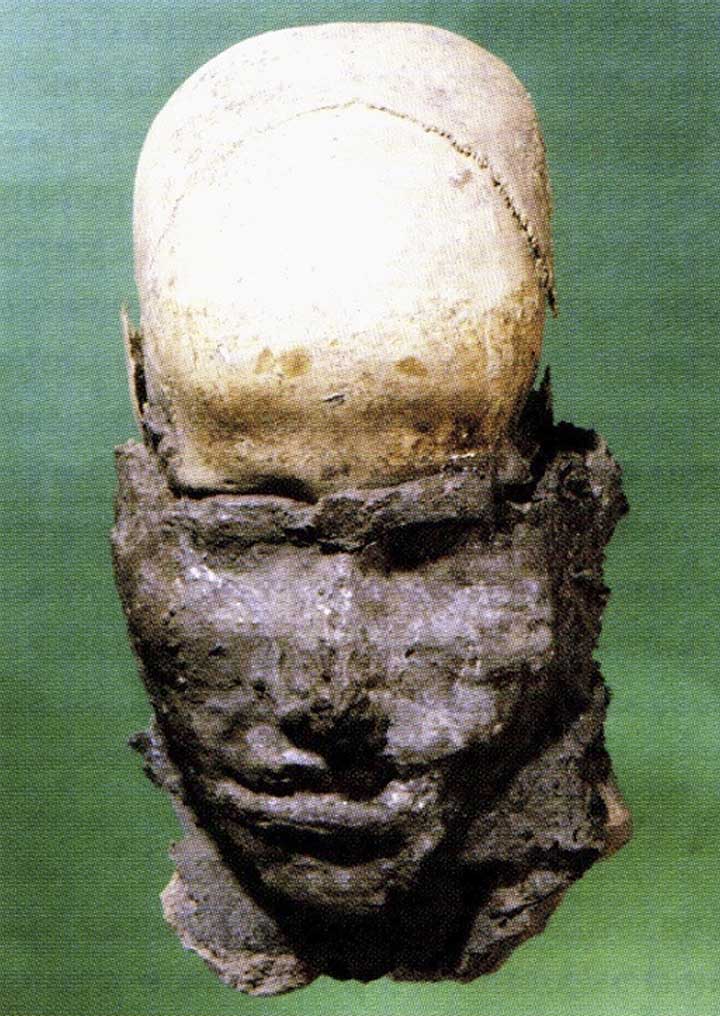
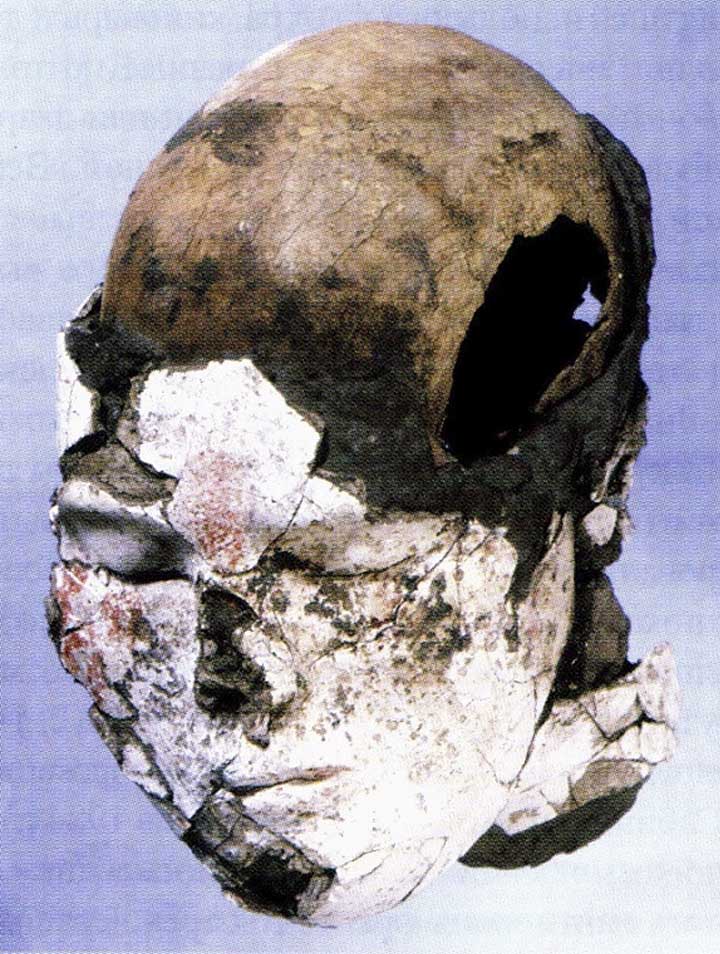
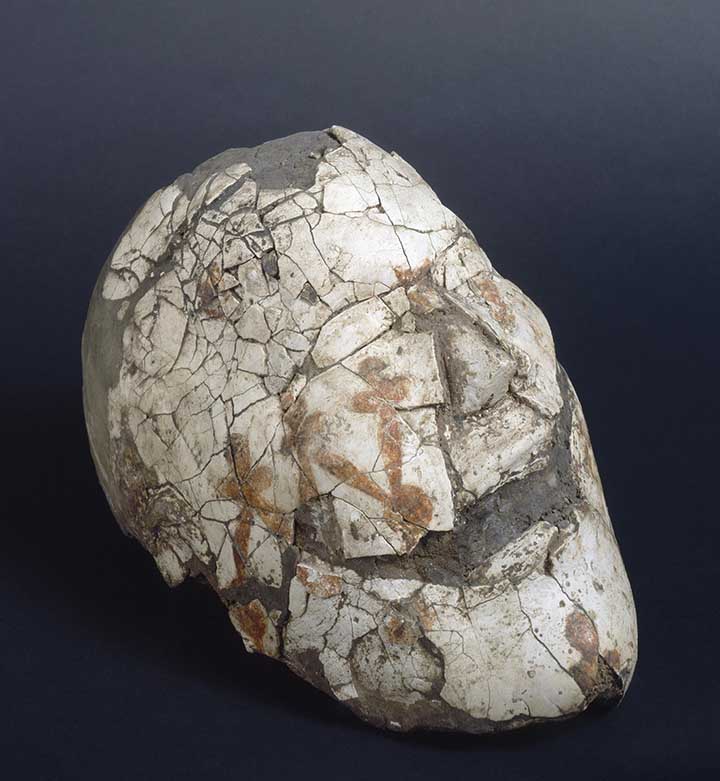
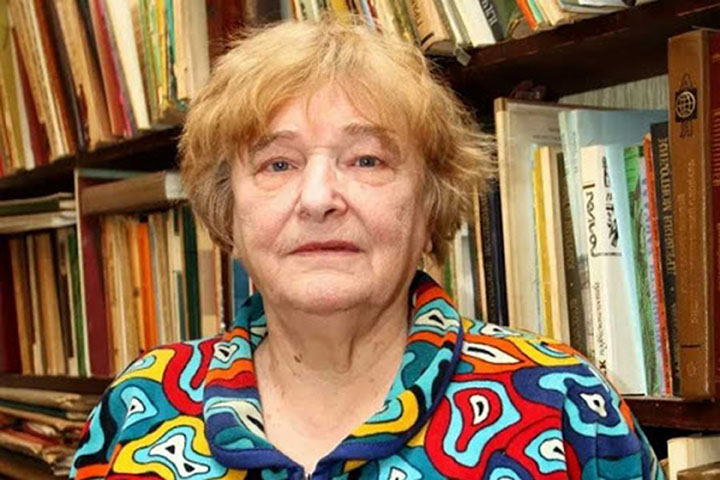
Monday 27 April 2020
The Cumans and Magyars
The History and Legacy of the Steppe Nomads Who Raided Europe Throughout the Late Middle Ages
- Paperback: 135 pages
- Publisher: Independently published (8 April 2020)
- Language: English
- ISBN-13: 979-8635405147
Before the Mongols rode across the steppes of Asia and Eastern Europe, the Cumans were a major military and cultural force that monarchs from China to Hungary and from Russia to the Byzantine Empire faced, often losing armies and cities in the process. The Cumans were a tribe of Turkic nomads who rode the steppes looking for plunder and riches, but they rarely stayed long after they got what they wanted.
From the late 9th century until the arrival of the Mongols in 1223, there was virtually nothing that could be done to stop the Cumans. Old Russian chronicles, Byzantine texts, Western European chronicles, and travel diaries of Islamic scholars all reveal that the Cumans were a threat to any kingdom in their path. Some kingdoms chose to fight the Cumans and often suffered heavy destruction, while others believed buying them off was the more reasonable course of action. The latter course often brought them into intimate contact with the most powerful kingdoms of medieval Eastern Europe before the Cumans were eventually replaced by the Mongols, with the remaining Cumans dispersing and integrating into various European and central Asian kingdoms in the 13th century. Many Cumans joined the Mongol Golden Horde and later became Muslims, while some helped found dynasties in Bulgaria, Hungary, and Romania.
The Cumans came from somewhat mysterious origins before they became the western vanguard of a massive nomadic horde that grew in ferocity and effectiveness as the centuries passed, but they were far more than mindless barbarians interested in violence alone. Although violence did play a major role in early Cuman culture, sources reveal they were also interested in diplomacy and eventually integrated with their sedentary neighbors. Archaeological discoveries further indicate that their culture was unique, complete with mythology and some art, but in the end, the Cumans disappeared as quickly as they appeared on the historical scene, much like other nomadic peoples before and after them.
Of all the steppe peoples in the medieval period, perhaps none were more important to European history than the Magyars. Like the Huns and Avars before them and the Cumans and Mongols after them, the Magyars burst into Europe as a destructive, unstoppable horde, taking whatever they wanted and leaving a steady stream of misery in their wake. They used much of the same tactics as the other steppe peoples and lived a similar, nomadic lifestyle. The Magyars also had many early cultural affinities with other steppe peoples, following a similar religion and ideas of kingship and nobility, among other things.
That said, as similar as the Magyars may have been to other steppe nomads before and after them, they were noticeably different in one way: the Magyars settled down and became a part of Europe and Western Civilization in the Middle Ages. The Magyars exploded onto the European cultural scene in the late 9th century as foreign marauders, but they made alliances with many important kingdoms in less than a century and established their own dynasty in the area, roughly equivalent to the modern nation-state of Hungary. After establishing themselves as a legitimate dynasty among their European peers, the Magyars formed a sort of cultural bridge between the Roman Catholic kingdoms of Western Europe and the Orthodox Christian kingdoms of Eastern Europe. Ultimately, the Magyars chose the Roman Catholic Church, thereby becoming a part of the West and tying their fate to it for the remainder of the Middle Ages.
The Cumans and Magyars: The History and Legacy of the Steppe Nomads Who Raided Europe Throughout the Late Middle Ages examines how the Cumans and Magyars became influential players in the region, and the influence they had.









